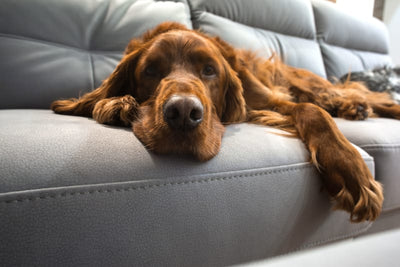Is stinky dog breath stopping you in your tracks? I can relate! My dog, Bubble has funky dog breath that I thought was normal for a dog. It wasn’t until much later that I learned bad dog breath can be a sign of dental health issues. Gum disease is the most common health issue in dogs. So it’s important to learn how to clean your dog’s teeth at home. But let’s be honest, life gets busy! We may mean to clean our dog’s teeth but forget. Or we may not want to fight with our dogs and give up trying. My dog’s health is important to me but my dog doesn’t like having his teeth brushed every day so I found other easy solutions to help me clean my dog’s teeth without brushing. Although these dental solutions don’t replace tooth brushing, these alternatives give me peace of mind.
How To Remove Plaque And Tartar From Dog Teeth Without Brushing
What Is Periodontal Disease Or Gum Disease In Dogs?
Periodontal disease in dogs, also known as periodontitis and gum disease, is caused by the accumulation of bacteria on the gum line. When this bacteria is not brushed away, it becomes dental plaque which hardens into calculus. This is called tartar and it becomes difficult to scarp off the teeth with regular brushing. Over time the accumulation of tartar leads to inflammation that affects dog teeth and the surrounding structures in the mouth. This can cause chronic gum pain, gum erosion, and loss of teeth.
There are four stages of periodontal disease in dogs. Each stage presents with different symptoms, prognoses, and treatments. In stage 1, dogs present with red gums, gums that bleed during brushing, and bad breath. With proper dental care, the prognosis is good at this stage. In stage 2, the dog’s gums may start to recede. By stage 3, gum recession may lead to losing teeth. The prognosis at this stage is fair and treatment includes advanced dental procedures. By stage 4 of periodontal disease in dogs, you may see tooth root exposure, loose teeth, or missing teeth. The prognosis at this stage is poor and teeth may need to be extracted. Cleaning your dog’s teeth at home, routine veterinary check-ups, and dental cleanings are important to the prevention of gum disease in dogs.
Why Clean Dog’s Teeth?
According to this study, gum disease is the most common health issue in dogs affecting at least 80% of dogs over 3 years of age. Your dog may present with innocent bad breath in the beginning. But over time, gum disease can lead to some serious health issues in your dog such as chronic gum pain, root exposure of teeth, teeth abscesses, and loss of bone and teeth. Cleaning your dog’s teeth at home can prevent periodontal disease.
How To Brush Your Dog’s Teeth At Home.
Although this article is focused on how to clean your dog’s teeth without brushing. It’s important to know how to brush your dog’s teeth at home. I had the pleasure of interviewing Carolina Szoda, a veterinary nurse with over 16 years of experience working in general practice and at emergency hospitals. I asked her many questions about dog dental health. One question was “what is the proper technique for brushing a dog’s teeth at home.”
Carolina advises putting your dog in a good position to make it easier for you to brush. “Use a little dab of toothpaste at a time because your dog will lick it off.” “When brushing, there is no rule of thumb on how long you should brush every tooth as long as you get toothpaste on the tooth and physically move the toothbrush on the tooth.” It helps to mechanically remove the bacteria and plaque that form on the dog’s teeth. She advises to “split your dog’s mouth into 4 quadrants. Focus on each section to get all the teeth from the canines, incisors, and molars in the back of the mouth.” Carolina states “the molars get the most tartar because it’s difficult to brush the back of the mouth.” She encourages us to “pull back your dog’s lip to get to the back of the mouth.”
How To Clean Dog Teeth Without Brushing
Now that you know the proper technique for brushing your dog’s teeth at home, what do you do when you don’t have the time to brush? Below you’ll find how to clean dog teeth that do not include brushing with a toothbrush. These dental products work better for some dogs than others but shouldn’t replace tooth brushing and professional dental cleanings done by your vet.
Dog Dental Finger Wipes Or Gauze
Dog dental finger wipes are a good option for dogs that do not tolerate a toothbrush. Simply put it on your finger and rub your dog’s teeth and gums paying attention to areas that have plaque build-up. You don’t even need toothpaste. Don’t forget to pull your dog’s lip back to expose the back teeth. The dental wipes make it easy to have good control of the areas of your dog’s mouth you want to focus on.
These dental finger wipes for pets work by removing the bacteria on the surface of your dog’s teeth. Some wipes include ingredients such as sodium hexametaphosphate that help break down calcium in the tartar and others have ingredients that may decrease bacteria in the mouth.
My dog tolerated Vet’s Best Dental Finger Wipes more than a regular toothbrush and I appreciated that I didn’t need to worry about dog toothpaste.
Although a great option to remove bacteria on the surface of the tooth, dental wipes may miss the small spaces, especially along the gum line.
Dental Treats And Chews To Clean Dog Teeth Without Brushing
There are a wide variety of dog dental treats and chews on the market that may help reduce plaque and tartar such as rawhide chews, dental treats, and rubber or nylon chew toys. These dental treats and chews work by mechanically scraping the plaque on your dog’s teeth as they chew. They can help improve teeth and gum health by reducing bad breath and the build-up of bacteria or plaque on the teeth.
When choosing the right dental treatment for your dog look for products that have been tested and approved by the Veterinary Oral Health Council (VOHC). Dental treats that have been approved by VOHC include Greenies and Virbac C.E.T. Veggiedent Chews. Make sure to get the size that best fits your dog so they do not consume them too quickly. Aggressive chewers may even swallow pieces whole. Always supervise your dog while they chew.
Rawhide chews such as Virbac C.E.T. rawhide chews and dog chew toys like these KONG toys may help improve mouth health, last longer than dental treats, and provide mental stimulation while your dog chews.
Risks in using dog dental treats and chews include an upset stomach, being high in calories, fracturing teeth from chewing hard bones, and possible digestive tract blockage from eating large pieces.
Raw Bones Or Meaty Bones For Dogs
Raw bones or raw meaty bones are edible bones covered in raw muscle meat and connective tissues. There are many benefits of feeding raw uncooked bones to dogs including dental hygiene. As your dog chews, the mechanical movement helps prevent plaque build-up on the teeth. Raw meaty bones also provide mental stimulation.
Select raw meaty bones that are an appropriate size for your dog and always supervise when they chew. Risks are similar to dental treats and chews which include upset stomach, fracturing teeth on hard bones, and possible digestive tract blockage from eating large pieces.
Use Dental Water Additives To Clean Dog Teeth
Dental water additives are formulated liquids administered with your dog’s water as they simply drink it. Many are tasteless products so your dog will not even notice it’s been added to their water. Depending on the brand, the additives work by containing natural or artificial ingredients that break down plaque and decrease bacteria on the dog’s teeth. As with other pet dental products, look for the VOHC seal of approval. Stick with natural ingredients such as zinc chloride and avoid artificial ingredients such as dyes. Simply pouring these additives into the water makes it easy for dog owners to use, including me. But keep in mind it doesn’t take the place of manual teeth brushing.
Dental Food Additives
Similar to water additives, dental food additives are formulated powders or granules that are sprinkled on your dog’s food. Proden Plaqueoff has ingredients such as seaweed which is known to have an enzyme called Bacillus licheniformis. The enzyme protects against tooth decay by stripping bacteria away from plaque. Dental food additives are easy to use, simply sprinkle them on your dog’s food. Additives shouldn’t replace teeth brushing but rather be used together for best results.
Dog Dental Sprays
Similar to water additives, dental sprays are formulated liquids that are applied directly to your dog’s teeth and gum line. Depending on the brand, dental sprays have different active ingredients that may reduce bad breath, reduce plaque, and have antibacterial properties.
April may be pet dental health month but our dog’s dental health is important all year long. We may have good intentions to brush our dog’s teeth every day. But in reality, life gets in the way. Using alternative dental solutions on days we can’t brush is how we can show love and keep our dogs healthy!






